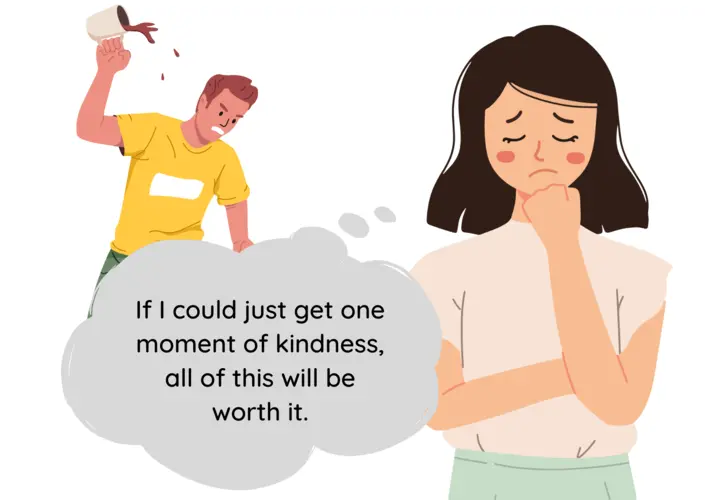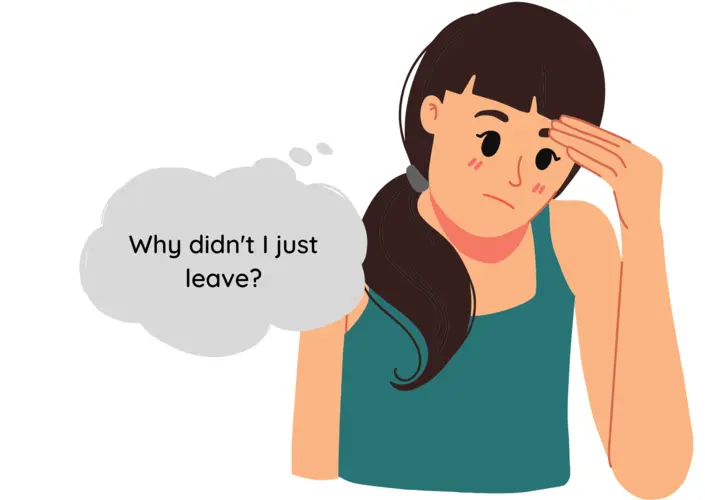An interesting question we received during our last support group meeting was, “Why do trauma bonds feel like an addiction?”
Trauma bonds feel like an addiction because when you are trauma-bonded, you crave the “high” of intermittent affection the abuser gives, you experience a severe loss of control, and because trauma bonding causes you to remain in the relationship despite the harmful consequences.
In this article, I will guide you through these three reasons to help you better understand the reason trauma bonds often feel like an addiction.
1.) You Crave the “High” of Intermittent Affection
In the context of trauma bonding, craving isn’t about wanting something enjoyable. It’s about seeking relief from the pain and confusion the abuser causes.
It’s a longing for validation, love, or a hint of tenderness in an environment that swings back and forth unpredictably between abuse and affection.
The person trapped in such a bond becomes hyper-focused on those rare moments of kindness, which, for them, become like a soothing balm applied to a painful injury.
As brief as they might be, these moments stand out as beacons of hope against the overall darkness of the abuse.
Because of this, the person trapped in this bond begins to deeply desire these moments of kindness.

For them, these moments of kindness are not just an escape from the pain; it’s a sign they are being valued and recognized as human beings.
This dynamic closely mirrors the push-pull of addiction.
When a person is addicted to a substance, they’re not just chasing the high.
They are often trying to escape some pain or emptiness, seeking comfort in whatever temporary relief the substance provides.
Similarly, for someone trapped in a trauma bond, the moments of kindness from their abuser offer a brief escape from their harsh reality.
They begin to obsessively seek these moments as they become equated with self-worth and validation.
Furthermore, the inconsistency of the abuser’s moments of kindness intensifies the target’s longing for those moments.
The target cannot predict when they might receive another moment of affection, making them all the more desperate and attentive to their abuser’s whims.
Think of this like a gambler at a slot machine, pouring coin after coin because they never know which pull might result in a win.
In the context of a trauma bond, the abused individual is perpetually hopeful, always looking for that next moment of warmth or validation.
This deepens the bond and solidifies the cycle of craving.
2.) You Experience a Severe Loss of Personal Control
A common question asked by people who have experienced a trauma-bonded relationship in the past or by those who are currently experiencing one is:
“Why didn’t I just leave?” or “Why can’t I just leave?”

When a person is in a trauma-bond relationship, their ability to assert themselves and make independent decisions usually decreases.
Therefore, this isn’t a simple matter of just one day choosing to leave the abuser.
Many emotions and psychological manipulations play a significant role in the continuation of many trauma-bonded relationships.
Suggested Reading: 8 Powerful Tactics That Narcissists Use to Control You
It’s like being caught in a rough sea, where every attempt to swim to the shore is countered by massive waves pulling them back into the ocean’s depths.
Just as a person struggling with addiction might find it hard to resist the pull of a substance or behavior, those in a trauma bond often feel helpless against the abuser.
Even though they’re rare, the positive moments anchor the person trapped in the trauma bond to the relationship, making it hard to see a way out.
This causes the target to become reliant on the abuser for a sense of stability, resulting in a decline in their self-confidence and decision-making abilities over time.
Once this happens, the target becomes tethered to the relationship, with the abuser holding the reins, guiding their emotions, perceptions, and, ultimately, their reality.
3.) You Remain in the Relationship Despite Harmful Consequences
In a trauma bond, staying in the damaging relationship can often feel unavoidable for the target, even when they’re aware of the harm it causes.
It’s like being stuck in quicksand: the more they try to pull away, the deeper they sink.

To tie this back to why trauma bonds feel like an addiction, I want you to imagine someone with an addiction.
They might know their habit is harmful, but the pull towards the substance is overpowering.
Similarly, someone in a trauma-bonded relationship might see the harm the relationship inflicts but feel trapped by emotional ties, fear, and hope.
As a result, the trauma-bonded person will often blame themselves for the relationship’s problems, thinking things like:
“If only I were better, they would treat me differently.”
This self-blame acts as a weight, keeping them anchored in the cycle of abuse.
Furthermore, the moments when the abuser is kind or affectionate (we discussed this in the first section of this article) can create a confusing contrast.
These brief, positive moments give false hope, making the trauma-bonded person believe things might improve or that the relationship has potential.
So, to wrap this section up, even when faced with clear signs of harm, leaving a trauma bond isn’t straightforward.
It’s not just about stepping out of a relationship but battling intertwined emotions of hope, self-doubt, and fear.
The situation resembles the addiction addicts feel toward the substances they use in that breaking free is far from easy, even when harm is evident.
Suggested Reading: How to Break a Trauma Bond with a Narcissist in 11 Steps
What Should You Take Away from This Article?
People with an addiction tend to show the three Cs:
1.) Craving for the object of the addiction.
2.) Loss of Control over the use of the object of the addiction
3.) Continued engagement despite the harmful consequences.
I hope this article has shown you how these three Cs appear in trauma-bonded relationships. Thank you so much for taking the time to read it.
About the Author

Hey, I’m Elijah.
I experienced narcissistic abuse for several years and was shocked by just how common it is. I create these articles to spread awareness.
But I’m not alone—there are many others here at Unfilteredd, all dedicated to helping people like you live a life free from the effects of narcissistic abuse.
If you’d like to learn more about how we can help, please click the button below.
